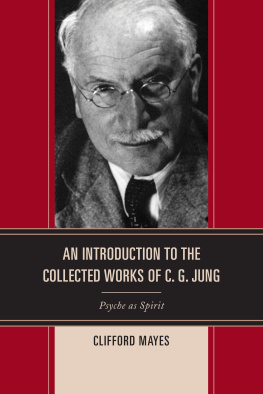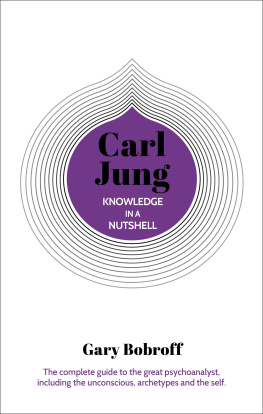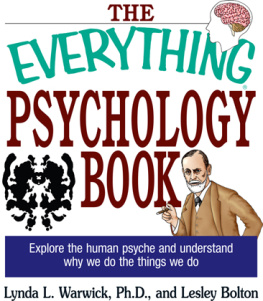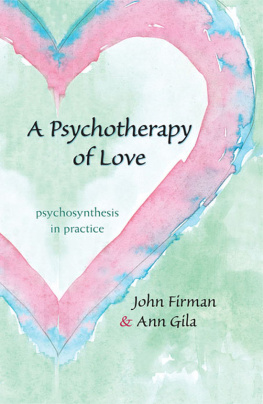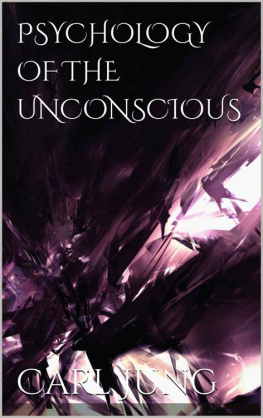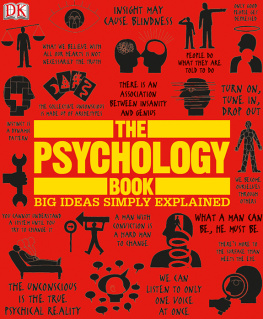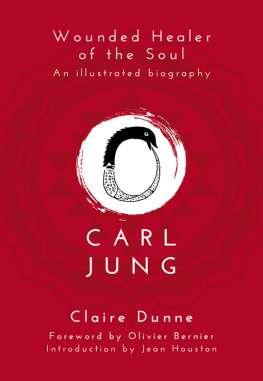BIBLIOGRAPHY
Alighieri, Dante, The Divine Comedy, Oxford Paperbacks, 1998
Assagioli, Roberto, Psychosynthesis, HarperCollins, 1993
Assagioli, Roberto, The Act of Will, David Platts Publishing Company, 1999
Benson, Jarlath, Old Wine in New Bottles, Year Two Course Book. Published by Amacara Press for the Institute of Psychosynthesis, 1992
Buber, Martin, I and Thou, Continuum books, New York, 2008
Chetwynd, Tom, A Dictionary of Symbols, Paladin, 1982
Grandin, Temple, Thinking in Pictures, Vintage Books, 2008
Hardy, Jean, A Psychology with a Soul, Woodgrange Press, 1996
Jung, Carl, Memories, Dreams, Reflections, Vintage 1989
Le Guin, Ursula, Earthsea Trilogy, Bantam 2006
Simpson, Joe, Touching the Void, Vintage New edition ,1998
Roszack, Theodore, Gnomes Mary, Ecopsychology, The Sierra Club Books, 1995
Tart, Charles, Beyond Ego, from the book The Spirit of Science, edited by David Lorimer, Floris Books, 1998
Whitmore, Diana, Psychosynthesis Counseling in Action, Sage Publications Ltd, 1998
CHAPTER 1
Roberto Assagioli, the Psychiatrist
True to his pioneering nature, Roberto Assagioli was years ahead of his time. As the young Italian medical doctor and psychoanalyst emerged into the exciting world of the early 19th century, he was already riding in the wake of some influential and well established psychiatrists and thinkers.
Carl Jung was practising analytical psychology in Zurich, and Sigmund Freud working and teaching in the field of psychoanalysis in Vienna. Simultaneously, breakthroughs in inventive thought were happening in other areas of scientific interest. Einstein was working on his theory of relativity. Austrian philosopher, Rudolph Steiner, following a background in theosophy, became involved in founding the Anthroposophical Society in Germany. Its principal aims were in furthering the study of spiritual science.
The American Wright brothers had built the first manned plane and flown in it. Henry Ford had invented the T Model car. Additionally, new ideas were taking off in the artistic arena with the founding of the literary Bloomsbury group, a flamboyant and talented network of characters such as Virginia Woolf, Lytton Strachey, Lady Ottoline Morrell and Bertrand Russell.
But soon after Jung had enthusiastically recommended Assagioli to Freud, Robertos initial ardor for the psychodynamic theory with its repressive elements in the unconscious waned. With hindsight, he saw the limitations of this model in that it failed to encompass the whole human being. If all states of awareness could be attributed to past experience that had become unconscious, how could the inherent potential be harnessed in a human being?
Already, Assagiolis vision was extending towards unearthing the wealth of talent that was endeavouring to emerge within the client. He understood how easily the client could become trapped in the past. His own historical background had opened his awareness to the creative and spiritual qualities waiting to be tapped and harnessed within each human being. But in order to reach an understanding of Assagiolis unique psychological practice it is important to include here the forces that underpinned his formative years. His mother was both Jewish and a theosophist with a circle of friends who shared a keen interest in esoteric as well spiritual teachings.
As an Italian scholar, the young Roberto was introduced to Dantes Divine Comedy which formed a mandatory part of his education. This had impressed him deeply. In fact, when he had completed his training as a psychiatrist and broadened his practice, Dantes work was to form the bedrock of his own beliefs. Further, Roberto fully identified with the 13th century poet who was imprisoned and exiled from Florence, his homeland, for the last twenty years of his life. Ironically, at one point Assagiolis own life was endangered as a Jew during the Second World War and he too was imprisoned and exiled for a brief period for his political beliefs. But, more than anything, he saw The Divine Comedy as a complete metaphor for the spiritual journey and, indeed, referred to it as a wonderful picture of a complete psychosynthesis. He equated the descent into the personality depths as Hell, or the Abyss, and then the aspiration towards transforming the lower aspects of the personality as Purgatory. Finally, as the I achieved union with the Self, the soul would enter into Paradise.
Yet, despite his early coaching in esoteric matters, Assagioli felt it was important to develop his practice as a scientific psychology which encompassed the whole of man. This psychology was to include creativity and will, as well as the often unconscious impulses and drives. Above all, he wanted his psychology to be practical and accessible to those who were drawn to the psychospiritual aspect of human development. Because of his background, he felt that this psychology should encompass the soul which could be used as a tool for self-development rather than self-analysis. He was not alone in holding the scientific context for his work. Both Jung and Freud had a similar need to do this. Indeed, Jungs fear of not being taken seriously did not allow his deeper writings to be released until after his death.
Roberto Assagioli was to develop a close relationship with Alice Bailey, a spiritual teacher, who wrote a number of esoteric books on humanitys spiritual development. She shared his concern and interest for the psychosocial problems in the world, realizing that both global conditions and individual problems were inexorably compounded together. He was keen to share his knowledge with others and set up various education establishments in his own country and throughout the world.
Roberto shared a love of mountaineering with other thinkers such as Nietzsche and Ruskin, which can be a compelling metaphor for their preoccupation with developing the latent potential lying within humanity. He used the mountain as a model for our relationship with the superconsciousness in his work.


